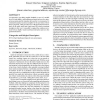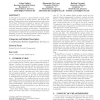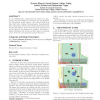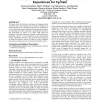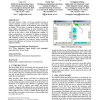MHCI
2009
Springer
14 years 7 months ago
2009
Springer
The haptic modality – the sense of touch – is utilized very limitedly in current human-computer interaction. Especially in mobile communication, the haptic modality could prov...
MHCI
2009
Springer
14 years 7 months ago
2009
Springer
With SeCuUI we present a solution that aims to increase security of data entry on public terminals. The user can enter all data requested by the terminal using her mobile device. ...
MHCI
2009
Springer
14 years 7 months ago
2009
Springer
An approach to providing tangible feedback to users of a mobile device in both highly visual touchscreen-based and eyes-free interaction scenarios and the transition between the t...
MHCI
2009
Springer
14 years 7 months ago
2009
Springer
In this paper we present a context-sensitive security model for privacy protection on mobile phones. We describe the system TreasurePhone which implements this security model. The...
MHCI
2009
Springer
14 years 7 months ago
2009
Springer
Speech and typed text are two common input modalities for mobile phones. However, little research has compared them in their ability to support annotation and retrieval of digital...
MHCI
2009
Springer
14 years 7 months ago
2009
Springer
This paper describes a novel tool for eliciting user requirements early in the design process of mobile applications. The “Mobile Oracle”, as we have called it, is intended to...
MHCI
2009
Springer
14 years 7 months ago
2009
Springer
In our FoxHunt game, virtual foxes are chased on a playground. Foxes and hunters are rendered on a map displayed on GPS-enabled mobile phones. We collected data from three field ...
MHCI
2009
Springer
14 years 7 months ago
2009
Springer
This paper charts the distinctive challenges of designing mobile experiences for cyclists and presents two studies of mobile cyclebased experiences: one a heritage tour; the other...
MHCI
2009
Springer
14 years 7 months ago
2009
Springer
As users enter web queries, real-time query expansion (RTQE) interfaces offer suggestions based on an index garnered from query logs. In selecting a suggestion, users can potentia...
MHCI
2009
Springer
14 years 7 months ago
2009
Springer

